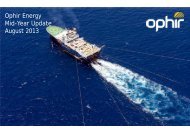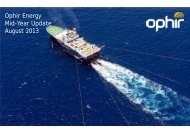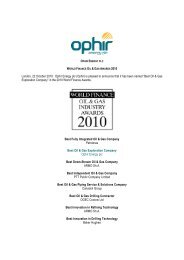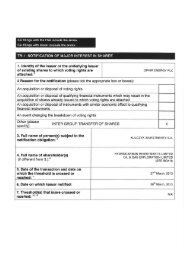Annual Report 2010 - Ophir Energy
Annual Report 2010 - Ophir Energy
Annual Report 2010 - Ophir Energy
Create successful ePaper yourself
Turn your PDF publications into a flip-book with our unique Google optimized e-Paper software.
18<br />
<strong>Ophir</strong> energy plc | <strong>2010</strong> ANNUAL REPORT<br />
BUsiness review | OPERATiONs REviEw<br />
Interest<br />
The Group has an 80% participating interest in Marovoay<br />
Block 2102 and is designated as the operator.<br />
Exploration and appraisal<br />
The sedimentary sequence comprises an eastern Permo-<br />
Triassic failed rift sediment infill and a western Jurassic-<br />
Cretaceous passive margin section. Management believe<br />
that the wide variety of structural styles, the influence of<br />
halokinesis, the presence of organic rich shales and<br />
hydrocarbons in nearby wells and at outcrop, together<br />
with potential reservoirs at the Permo-Triassic, Jurassic and<br />
Cretaceous levels make Marovoay Block 2102 an attractive<br />
block for further exploration. In addition, the use of<br />
high-resolution gravity gradiometry data provides an<br />
opportunity to benefit from the early application of new<br />
technology that was previously not available. Management<br />
believe that new insight afforded by the interpretation of<br />
these data could help reduce the risk associated with<br />
exploration drilling based on existing seismic data.<br />
The current exploration phase is due to expire on 8 July<br />
2011 and the Group is required to notify the Government<br />
of its election to move into the first extension period by<br />
8 June 2011. During the first extension period (which<br />
expires on 8 July 2013), there is an obligation to drill one<br />
exploration well.<br />
Berbera psA, somaliland<br />
Overview<br />
The geology of Somaliland is considered to be contiguous<br />
with that of Yemen. Reconstructions of the tectonic plates<br />
in the area as they were prior to the opening of the Gulf of<br />
Aden, suggest that the geological structures within the<br />
Berbera PSA were continuations of the rift basins in Yemen<br />
which host a substantial number of oil discoveries.<br />
In April 2003, Rova <strong>Energy</strong> Corporation Ltd (“Rova”)<br />
entered into the Berbera Block PSA (“Berbera PSA”) with<br />
the Government of Somaliland which was subsequently<br />
amended by an addendum in May 2006. Rova was a special<br />
purpose company established to acquire and develop the<br />
Berbera PSA. In return for providing early funding,<br />
Mvelaphanda was awarded an option to acquire 75% of<br />
Red Sea<br />
Eritrea<br />
Ethiopia<br />
Djibouti<br />
Yemen<br />
Berbera<br />
PSA<br />
Somaliland<br />
Gulf of Aden<br />
Somalia<br />
the issued share capital of Rova. The remaining 25% was<br />
held by a private individual. The Group acquired this option<br />
from Mvelaphanda in October 2004 and in March 2005<br />
exercised its option to acquire 75% of Rova. In February<br />
2007, the Group and the private individual agreed to<br />
exchange the Group’s shareholding in Rova for a direct<br />
interest in the Berbera PSA. This was subsequently ratified<br />
by the Government of Somaliland in March 2007 (with the<br />
transaction completing in May 2007) and the Group is now<br />
a direct participant in the Berbera PSA holding an interest of<br />
75% and is the designated operator. In 2008 Rova agreed<br />
to sell its 25% interest in the Berbera PSA to RAKGas.<br />
The Group and RAKGas currently participate in the<br />
Berbera PSA through a joint venture governed by a joint<br />
operating agreement.<br />
The Republic of Somaliland re-declared its independence<br />
from Somalia in 1991. It remains subject to a sovereignty<br />
dispute with neighbouring Somalia but is in active<br />
diplomatic discussions with surrounding states and the<br />
African Union regarding formal recognition of its<br />
independence.<br />
So long as sovereignty over the Berbera PSA area remains<br />
disputed, the Group’s rights and obligations in respect of its<br />
Somaliland assets also remain uncertain. As a consequence<br />
US$5.3 million was written off at 31 December <strong>2010</strong> for<br />
reasons of impairments. (Refer to note 9(ii) (a).)<br />
The Berbera PSA, located in northern Somaliland, is<br />
predominantly onshore but also extends offshore into the<br />
Gulf of Aden.<br />
Interest<br />
The Group owns 75% of the Berbera PSA and is designated<br />
as the operator.<br />
Exploration and appraisal<br />
Management believes that the petroleum geology of<br />
Somaliland is contiguous with that of Yemen (a territory<br />
where there have been significant oil discoveries and<br />
production). The Group acquired 2D seismic data offshore<br />
and completed an aeromagnetic survey over the onshore<br />
areas in Q1 2008. The Group is currently in the third<br />
exploration period which commenced on 1 December <strong>2010</strong>.<br />
Forward plan<br />
Following a re-interpretation of the surface and sub-surface<br />
geology the Group has identified locations where, following<br />
the acquisition of additional seismic data, it believes<br />
drillable prospects could be defined. Discussions with the<br />
Government of Somaliland are underway to re-configure<br />
the terms of the Berbera PSA to allow for the acquisition of<br />
new seismic data. If, following the acquisition of these data,<br />
it is possible to define risk covered prospects, the Group<br />
intends to drill one or possibly two exploration wells.<br />
Figure 9 - Berbera PSA - Somaliland








